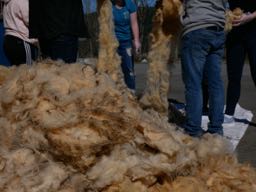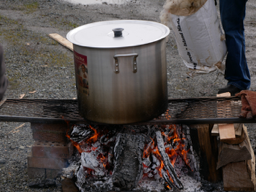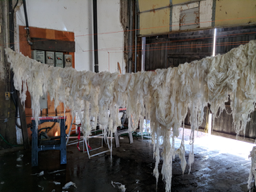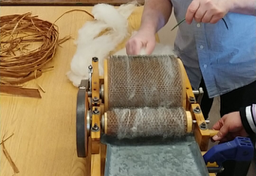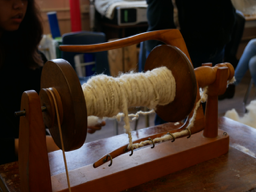Fibre processing
This section is based on my own family teachings as shared with the Land and Language Based Learning Program I co-teach with William Taylor. The teachings discussed in this section include fibre processing — cleaning, teasing, carding, and spinning – along with weaving. Working with fibres in our class offers us the opportunity to re-live ancient teachings, to re-awaken culture buried in our Coast Salish students. With this sensory engagement comes language: Hul’q’umi’num’ comes alive and words awaken with the teachings. As Chief Janice George from Squamish puts it, “weaving is part of the Salish tree of life; from the roots of this tree grow the teachings that form the Coast Salish Worldview.” Chief Janice George, Squamish (Tepper et al. 2017: 31).
Our program is based on traditional Coast Salish ways of learning. These practices come from my family’s teachings, and from the shared work of Coast Salish weavers and knitters. In our class, we tried to work ‘as Granny did’ so that the sense memories of past work could be brought into the present. In this way, visitors to our program could share memories brought forward by the work at hand. Our work together has demonstrated the richness of traditional teachings to awaken cultural knowledge and the power of working together — nutsumaat.
-
- Vocabulary
| lhun’um | weave | ||
| lhulhun’um’ | weaving | ||
| lumutoul’qun | wool | ||
| p’uq’ | white | ||
| tsq’ix | black | ||
| ts-hwikw’ | grey | ||
| ’uy’umun | loom | ||
| xpey’ | red cedar | ||
| hakwush | use | ||
| q’ul’q’t | wind, warp | ||
| q’el’q’t | winding, warping | ||
| stl’its | design | ||
| kw’shem | count | ||
| kw’shemutth’ | count the strands | ||
| ’akw’ut | weave, twine/twill | ||
| ’ukw’emutth’ | weaving strands | ||
| luxwtun | blanket | ||
| swuqw’a’lh | mountain goat wool blanket |
-
- Fibre processing and weaving
Uncleaned sheep fleece donated by Mary Hill, from Cobble Hill B.C., was taken to the beach to be cleaned in the early spring.
Figure 9 Raw wool, donated by Mary Hill
| lumutoul’qun | wool from sheep |
In the presence of Coast Salish elders, large metal pots were used to boil the fleece in for cleaning. Master Carver John Marston, and staff members of the Ladysmith Secondary School also assisted in this process.
Figure 10 Boiling the wool
Our students hung the washed wool to dry indoors on makeshift lines. As our grandparents did, we used the resources available to us to dry the fibres.
Figure 11 Hanging washed wool
| ‘e’uth ts’ey’hwul’qun’ ‘u tthu stth’utth’ixw lumutoul’qun | |
| She’s drying the washed wool. |
Our class came together to tease the wool we after we had cleaned it. In this process, stray bits of grass and dirt were removed to ensure that the sheep fleece can be efficiently carded.
| ‘e’uth they’xul’qun’ ‘u tthu p’uq’ lumutoul’qun | |
| She’s teasing the white wool. |
A carding machine was operated by students to form rovings to be spun into yarn. This process requires patience and skill, teaching us how important careful preparation is when creating a finished blanket.
Figure 12 Carding wool
Students learned how to spin the rovings made out of the wool we washed. Stz’uminus First Nation spinner and knitter Katherine Aleck visited our class to pass on her teachings.
| e’uth qequluts’ ‘u tthu p’uq’ lumutoul’qun | |
| She’s spinning the white wool. |
Figure 13 Spinning wool

